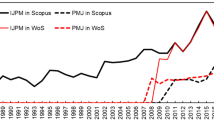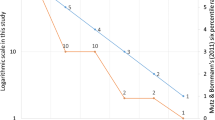Abstract
The journal Impact Factor (IF) is not comparable among fields of science and social science because of systematic differences in publication and citation behaviour across disciplines. In this work, a decomposing of the field aggregate impact factor into five normally distributed variables is presented. Considering these factors, a principal component analysis is employed to find the sources of the variance in the Journal Citation Reports (JCR) subject categories of science and social science. Although publication and citation behaviour differs largely across disciplines, principal components explain more than 78 % of the total variance and the average number of references per paper is not the primary factor explaining the variance in impact factors across categories. The categories normalized impact factor based on the JCR subject category list is proposed and compared with the IF. This normalization is achieved by considering all the indexing categories of each journal. An empirical application, with one hundred journals in two or more subject categories of economics and business, shows that the gap between rankings is reduced around 32 % in the journals analyzed. This gap is obtained as the maximum distance among the ranking percentiles from all categories where each journal is included.





Similar content being viewed by others
References
Althouse, B. M., West, J. D., Bergstrom, C. T., & Bergstrom, T. (2009). Differences in impact factor across fields and over time. Journal of the American Society for Information Science and Technology, 60(1), 27–34.
Bensman, S. J. (2007). Garfield and the impact factor. Annual Review of Information Science and Technology, 41(1), 93–155.
Bergstrom, C. (2007). Eigenfactor: Measuring the value and prestige of scholarly journals. College and Research Libraries News, 68(5), 314.
Bornmann, L., & Daniel, H. D. (2008). What do citation counts measure? A review of studies on citing behavior. Journal of Documentation, 64(1), 45–80.
Chen, J., & Konstan, J. A. (2010). Conference paper selectivity and impact. Communications of the ACM, 53(6), 79–83.
Dorta-González, P., & Dorta-González, M. I. (2010). Indicador bibliométrico basado en el índice h. Revista Española de Documentación Científica, 33(2), 225–245.
Dorta-González, P., & Dorta-González, M. I. (2011a). Aplicación empírica de un indicador bibliométrico basado en el índice h. Cultura y Educación, 23(2), 297–313.
Dorta-González, P., & Dorta-González, M. I. (2011b). Central indexes to the citation distribution: A complement to the h-index. Scientometrics, 88(3), 729–745.
Egghe, L., & Rousseau, R. (2002). A general framework for relative impact indicators. Canadian Journal of Information and Library Science, 27(1), 29–48.
Freyne, J., Coyle, L., Smyth, B., & Cunningham, P. (2010). Relative status of journal and conference publications in computer science. Communications of the ACM, 53(11), 124–132.
Garfield, E. (1972). Citation analysis as a tool in journal evaluation. Science, 178(4060), 471–479.
Garfield, E. (1979a). Citation indexing: Its theory and application in science, technology, and humanities. New York: Wiley.
Garfield, E. (1979b). Is citation analysis a legitimate evaluation tool? Scientometrics, 1(4), 359–375.
González-Pereira, B., Guerrero-Bote, V. P., & Moya-Anegón, F. (2011). A new approach to the metric of journals’ scientific prestige: The SJR indicator. Journal of Informetrics, 4(3), 379–391.
Leydesdorff, L. (2006). Can scientific journals be classified in terms of aggregated journal–journal citation relations using the Journal Citation Reports? Journal of the American Society for Information Science and Technology, 57(5), 601–613.
Leydesdorff, L., & Bornmann, (2011). How fractional counting of citations affects the Impact Factor: Normalization in terms of differences in citation potentials among fields of science. Journal of the American Society for Information Science and Technology, 62(2), 217–229.
Leydesdorff, L., & Opthof, T. (2010a). Normalization at the field level: Fractional counting of citations. Journal of Informetrics, 4(4), 644–646.
Leydesdorff, L., & Opthof, T. (2010b). Scopus’s source normalized impact per paper (SNIP) versus a journal impact factor based on fractional counting of citations. Journal of the American Society for Information Science and Technology, 61(11), 2365–2369.
Leydesdorff, L., & Rafols, I. (2011). Indicators of the interdisciplinarity of journals: Diversity, centrality, and citations. Journal of Informetrics, 5(1), 87–100.
Moed, H. F. (2010). Measuring contextual citation impact of scientific journals. Journal of Informetrics, 4(3), 265–277.
Opthof, T., & Leydesdorff, L. (2010). Caveats for the journal and field normalizations in the CWTS (“Leiden”) evaluations of research performance. Journal of Informetrics, 4(3), 423–430.
Pudovkin, A. I., & Garfield, E. (2002). Algorithmic procedure for finding semantically related journals. Journal of the American Society for Information Science and Technology, 53(13), 1113–1119.
Rafols, I., & Leydesdorff, L. (2009). Content-based and algorithmic classifications of journals: Perspectives on the dynamics of scientific communication and indexer effects. Journal of the American Society for Information Science and Technology, 60(9), 1823–1835.
Ramírez, A. M., García, E. O., & Del Río, J. A. (2000). Renormalized impact factor. Scientometrics, 47(1), 3–9.
Rosvall, M., & Bergstrom, C. T. (2008). Maps of random walks on complex networks reveal community structure. Proceedings of the National Academy of Sciences, 105(4), 1118–1123.
Rosvall, M., & Bergstrom, C. T. (2010). Mapping change in large networks. PLoS ONE, 5(1), e8694.
Sombatsompop, N., & Markpin, T. (2005). Making an equality of ISI impact factors for different subject fields. Journal of the American Society for Information Science and Technology, 56(7), 676–683.
Van Raan, A. F. J., Van Leeuwen, T. N., Visser, M. S., Van Eck, N. J., & Waltman, L. (2010). Rivals for the crown: Reply to Opthof and Leydesdorff. Journal of Informetrics, 4(3), 431–435.
Wagner, C., Roessner, J. D., Bobb, K., Klein, J., Boyack, K., Keyton, J., et al. (2011). Approaches to understanding and measuring interdisciplinary scientific research (IDR): A review of the literature. Journal of Informetrics, 5(1), 14–26.
Waltman, L., & Van Eck, N. J. (2010). The relation between Eigenfactor, audience factor, and influence weight. Journal of the American Society for Information Science and Technology, 61(7), 1476–1486.
Waltman, L., Yan, E., & Van Eck, N. J. (2011). A recursive field-normalized bibliometric performance indicator: An application to the field of library and information science. Scientometrics, 89(1), 301–314.
Zitt, M., & Small, H. (2008). Modifying the journal impact factor by fractional citation weighting: The audience factor. Journal of the American Society for Information Science and Technology, 59(11), 1856–1860.
Acknowledgments
This research has been supported by the Ministry of Science and Technology of Spain under the research project ECO2008-05589.
Author information
Authors and Affiliations
Corresponding author
Electronic supplementary material
Below is the link to the electronic supplementary material.
Rights and permissions
About this article
Cite this article
Dorta-González, P., Dorta-González, M.I. Comparing journals from different fields of science and social science through a JCR subject categories normalized impact factor. Scientometrics 95, 645–672 (2013). https://doi.org/10.1007/s11192-012-0929-9
Received:
Published:
Issue Date:
DOI: https://doi.org/10.1007/s11192-012-0929-9




